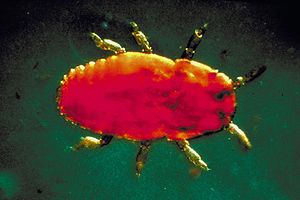Pine stem louse
| Pine stem louse | ||||||||||||
|---|---|---|---|---|---|---|---|---|---|---|---|---|

Pine stem louse ( Adelges piceae ), juvenile form |
||||||||||||
| Systematics | ||||||||||||
|
||||||||||||
| Scientific name | ||||||||||||
| Adelges piceae | ||||||||||||
| Ratzeburg , 1844 |
The pine stem louse ( Adelges piceae , Syn . : Chermes piceae , Dreyfusia piceae ) is a species from the genus Adelges in the family Adelgidae . It is a dangerous pest on fir trees ( Abies ).
description
Adult animals are blackish-red in color and approximately spherical in shape. They grow up to 1 millimeter in size and are therefore almost invisible to the naked eye. Your body is covered with fine white wax threads and makes them appear like little balls of wool. The juvenile form is colored orange and has black eyes. The eggs are orange.
Similar Art
distribution and habitat
The natural range of the pine trunk louse includes Central Europe . It was introduced to North America and is common wherever its food crops are found. Furthermore, the spread is limited by the snow line and regions with cold weather.
The species can be found both in natural forests and in plantations.
nutrition
The pine stem louse sucks on all types of fir, but attacks the balsam fir ( Abies balsamea ) and the Fraser fir ( Abies fraseri ) particularly frequently. You can find the animals scattered all over the tree where they are able to reach the parenchyma with their mouthparts .
Way of life
Two generations, sometimes three in the southern Appalachians , are trained each year. The eggs of the first generation are laid in June and July, those of the second generation in September and October. Each female is able to lay up to 200 eggs. Since there are only females in North America, reproduction occurs asexually. The pine stem louse is only able to move independently in its juvenile form. As soon as this juvenile form begins to eat, the first larval stage occurs and the animals are unable to move. The species overwinters in the first larval stage and continues to develop in the following spring. The eggs and larvae can fall from the host trees and be inadvertently spread by humans, animals, and vehicles. The youth form is able to cover distances of up to 30 meters independently.
Predators
The conifer ladybird ( Aphidecta obliterata ), Laricobius erichsonii and Pullus impexus as well as the gall mosquito Aphidoletes thompsoni , Cremifania nigrocellulata and the aphid fly Leucopis obscura are natural predators of the pine stem louse. They were introduced to North America with moderate success.
Harmful effect
While ingesting food, the host tree is stimulated to produce abnormal wood cells. These wood cells reduce the tree's ability to carry water and nutrients. The first signs of an infestation are deformation of the buds and the death of branches and twigs. Persistent infestation leads to the inhibition of growth in height and thickness. The needles are thrown off, reducing the ability to photosynthesize . Needles that are discarded naturally will no longer be replaced. Infested trees can die after 3 to 4 years.
Combat
Effective but expensive control with chemicals is possible. This is only used for stocks that are used for seed or Christmas tree production. Another control method is the felling and burning of infected trees. Natural enemies have been introduced into North America, but these have proven to be quite unreliable. Sometimes the infected trees are able to fight the pine stem louse themselves.
meaning
The pine stem louse is a dangerous pest in North America and is particularly a threat to stocks that are used for seed production and for the production of Christmas trees . Natural forests are also endangered by an infestation. The wood from infested trees loses quality. The species does not pose a threat to Asian and European fir species.
swell
Individual evidence
- ↑ a b Entry at BioLib.cz accessed on July 10, 2010
- ↑ a b c d entry at Forestpests.org
- ↑ a b c d e f g h i Entry in the Global Invasive Species Database

